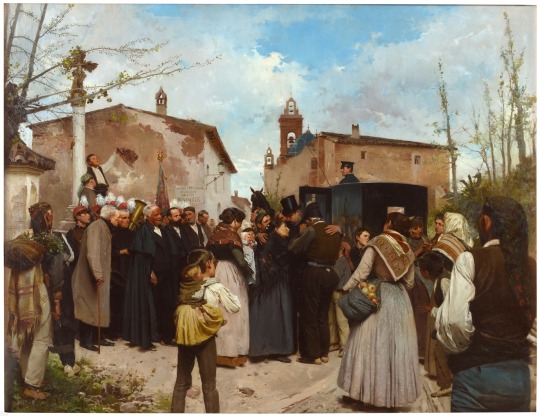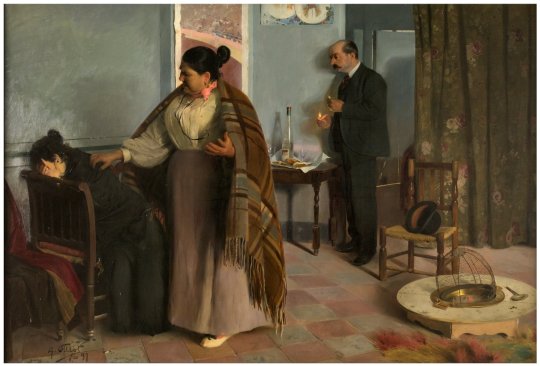#fillol
Explore tagged Tumblr posts
Photo

Un día como hoy, pero de 1972, Ubaldo #Fillol debutó con la camiseta de #RACING en el triunfo por 3-2 frente a #Huracán. 👉 Tuvo dos etapas en el club, en la segunda se coronó con la Supercopa y la Interamericana. ¡GRANDE, PATO! 💙🙌🏼 https://www.instagram.com/p/CpLExaXhTUDAObFI1gtPTkZX5J4elPjcI1ZX200/?igshid=NGJjMDIxMWI=
0 notes
Text

Antonio Fillol Granell (Spanish, 1870-1930) La defensa de la choza, 1895 Museo Nacional del Prado, Madrid
#Antonio Fillol Granell#spanish art#spanish#la defensa de la choza#1895#1800s#art#fine art#european art#classical art#europe#european#fine arts#oil painting#europa#mediterranean#Phrygian cap#phrygian
13 notes
·
View notes
Text

Antonio Fillol Granell: O sátiro
5 notes
·
View notes
Text

Edward Seymour & Catherine Fillol
Although no marriage had been arranged for Jane, her parents had provided a bride for their eldest surviving son, Edward, in around 1519. The chosen bride was Catherine, daughter of Sir William Fillol of Woodlands in Horton, Dorset. Jane came to know Catherine Fillol well during her childhood although there is no record that the pair were close. The age gap was large and Catherine may always have seen Jane only as her husband’s younger sister. Jane shared in the joy of the rest of her family when Catherine bore Edward two sons in quick succession: John and Edward. Even before she reached home in 1533, Jane would have been aware that things had changed and that Catherine would no longer be there. The marriage had entirely broken down by 1528, the year of the death of Catherine’s father. Before his death, Sir William disinherited his daughter, son-in-law and his grandchildren.

What happened in Edward and Catherine's marriage? Possibly a scandal came to light, and she was repudiated by her husband. Rumour suggests that Catherine’s repudiation was on the grounds of infidelity and this affected both her future and that of her sons. It is likely that Edward did indeed find his wife in a compromising position with a gentleman of his acquaintance. To the shame of both Jane and the rest of her family, it has been suggested that that Catherine’s lover was a gentleman that the Seymour family knew very well indeed.

Edward Seymour was often away from his family in the 1520s and he left his wife alone with his parents at Wolfhall. Catherine must have felt lonely and it has been suggested that her father-in-law, Sir John Seymour, sought to comfort her during this time. According to this interpretation, Sir John and Catherine became lovers, defying both church law and all convention. This affair lasted some time and, when Edward discovered it, the consequences were explosive. Edward sent a distraught Catherine to a nunnery and, whilst he talked openly of divorcing her, he never took the final step, instead waiting for her early death to allow him to marry again.

From the trauma that followed Edward’s discovery of the affair, enough doubt was cast on the paternity of Catherine’s elder son, for Edward to cease considering himself his father. The younger son, who escaped this censure, also received his father’s anger. The relationship between Edward and his father would also have been irreparably damaged and, whilst relations between the two men somewhat cooled following Edward’s second marriage to the aristocratic Anne Stanhope, they were never fully mended. Edward received a land grant in 1540, the grant details the line of heirs for it after Edward's death. The inheritance would first go to the children with his second wife, and if that line died out, it would then go to his second son by Catherine Fillol. His eldest son John is excluded entirely.
Elizabeth Norton, Jane Seymour: Henry VIII's True Love
9 notes
·
View notes
Text

Rafael Federman in Matadero (2022, dir Santiago Fillol)
6 notes
·
View notes
Note
Did john seymour have a relationship with his daughter in law? I thought he did but I was reading kyra kramer say there was no evidence for it
There's like, a note about that on some 17th century text? I think that's the extent of that evidence.
Basically we're working backwards when we look at the Seymours, but we see that Edward Seymour disinherited his sons by Fillol via Parliament and that she was forced into a nunnery, it has to be adultery allegations of some kind, was it with her father-in-law (questions of consent here if so, she was a young teenager, they lived in his household and he was head of that household, they were beholden to him financially, was she in much of a position to refuse advances? coercive consent etc), any of the servants of the household, Thomas Seymour himself (Suzannah Dunn theorized this as reason for the deep-held animosity between the brothers), all of the above (you'd think rumors would reach farther were that the case); who knows.
Edit:
Okay, I’m going to have to look more into the claim that she was placed in a convent, because Loades was the preeminent historian on the Seymours and he doesn’t even mention that...seems odd:
“His bride, who he wed at some point before 1518*, was Catherine Fillol, the daughter and co-heir of William Fillol, who had lands in Dorset and Essex. Given his youth at the time, this was almost certainly an arranged match for which his father was responsible, and in spite of producing two sons it was not a success. At some point after 1530 he repudiated her, alleging adultery. This did not affect the legitimacy of their children, but they played no part in his subsequent career, and had no claims to his titles. [...] Both were children when their mother was repudiated, and were brought up by her until her death in 1535**, at which point their care reverted to their father. However, he remarried Anne Stanhoppe [...] They were provided by out of their mother’s inheritance*** and in 1538, probably on Anne’s insistence****, were excluded from their father’s properties and titles by Acts of Parliament in 1538.
His future was reserved for his children by Anne [...] His sister Jane, for all her gentle nature, never showed the slightest interest in her nephews.”
*again...they were both very young, it just overall seems like a very sad situation
**????
***I’ve also read elsewhere that Edward didn’t actually pay them what they were owed of their mother’s inheritance, so, idk
****male historians always say this, lmao...Edward was a grown-ass man, he is the one accountable for the decisions he made about his children (that they weren’t claimed illegitimate assumes he still recognized them as such, they had the surname, etc) edit: the source for AH being the one that pushed this is the same that says Edward Seymour divined Catherine’s adultery via sorcerer in France, so...hill of salt?
Edit 2:
Okay, here’s information on the will by Catherine’s father, might shed some more light:
“Her father must have had a certain degree of confidence [in her], for in 1519 he named her executor of his will [...]
Yet William’s affection for his daughter must have radically altered, [for in 1527] he disinherited his daughter, son-in-law, and grandchildren, [...] his only legacy to Catherine an annual pension, ‘as long as she shall live virtuously and abide in some religious house of women.’
It appears that in 1528 Catherine and Seymour had separated, but the precise reason remains obscure.
[133 years after the fact, historian Heylin recorded ‘a story’ that Seymour while in France divined his wife’s infidelity by magic... ?]
The ‘contingent’ provision in Parliament [disinherited] John Seymour entirely, [his younger son Edward could inherit if Edward had no other male heirs]
There is a marginal note in Vincent’s Baronage in the College of Arms [suggesting adultery between father-in-law and daughter-in-law]. However, while John Seymour did have an illegitimate son, also named John, there is no evidence supporting this suggestion of incest nor anything that suggests Edward Seymour’s relationship with his father was permanently ruined.
After his father’s death, John sought the restitution of his mother’s inheritance [...] Sir Edward was restored in blood by Parliament in March 1553.”
#anon#yeah...it looks like these sons of fillol didn't get much in the way of inheritance until their (probable) father was executed#which uh... woof#edward seymour seems like a complete asshole im ngl#and ...so he had more suspicion john's paternity was not his than edward? is what im getting from this
10 notes
·
View notes
Text

Antonio Fillol Granell, La gloria del pueblo, 1895 x
5 notes
·
View notes
Text
Emma Cook Spring 2005 Ready-to-Wear




#emma cook#runway#fashion#spring#2005#ready to wear#Lily Donaldson#Valentine Fillol-Cordier#Madeleine Blomberg
0 notes
Link
Com a proximidade a Portugal, e com um elevado número de incêndios que fustigam os dois países nos últimos anos, esperava uma abordagem ampla que auxiliasse a compreensão do fenómeno... O filme centra~se (apenas) na história de um incendiário que retorna a casa, e é acolhido com desconfiança pela sua comunidade.
Boa fotografia, autenticidade dos actores. e realismo.
0 notes
Text

0 notes
Text

Fillol (Argentina).
24 notes
·
View notes
Text

Feuille rousse, feuille folle... Feuille rousse, feuille folle Tourne, tourne, tourne et vole ! Tu voltiges au vent léger.... Sur le chemin de l’école, J’ai rempli tout mon panier Des jolies feuilles du sentier. Feuille rousse, feuille folle ! Dans le vent qui vole, vole, J’ai cueilli pour mon cahier la feuille qui dansait.
Luce Fillol


34 notes
·
View notes
Note
Thank you for answering my question about Katherine fillol and John Seymour, made the mistake of trusting Alison Weir on that. Do you have any historical Tudor Fiction recs that are accurate?
no worries! i think a few biographies take for granted that it happened, and there’s no reason to argue that it definitely didn’t (we genuinely don't know enough to completely dismiss it). but, likewise, i think often the anecdote of their affair is repeated without much attention actually being paid to it. i don’t think i have seen any historian really talk about the fact that john seymour is supposed to have groomed and impregnated an eleven year old girl…
but unforch i don’t really read tudor fiction so i can’t really recommend any, i’m afraid!
2 notes
·
View notes
Text

Antonio Fillol: A besta humana. 1897
3 notes
·
View notes

